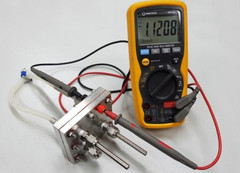Researchers have been trying to come up with alternatives to Lithium-Ion batteries for a few decades now. Some new technologies promise enticing possibilities, but are still quite far away from mass market adoption. The latest competitor for a true successor to the Lithium-ion throne is the proton battery developed by researchers at RMIT University of Melbourne, and this one promises to be an environmentally-friendly solution that can see mass production in 5 years on top.
Lead researcher John Andrews claims that the proton batteries are also less expensive to produce compared to Lithium-ion or hydro energy sources: “Powering batteries with protons has the potential to be more economical than using lithium ions, which are made from scarce resources. Carbon, which is the primary resource used in our proton battery, is abundant and cheap compared to both metal hydrogen-storage alloys, and the lithium needed for rechargeable lithium ion batteries.”
As it uses carbon that is not burnt in open air, the proton battery is considered one of the most eco-friendly solution to date. The current 5.5 square centimeters proton battery prototype can store as much energy-per-mass as a Lithoum-ion battery, but the RMIT researchers are now looking to further improve the efficiency. In this respect, Andrews notes that “future work will now focus on further improving performance and energy density through use of atomically-thin layered carbon-based materials such as graphene, with the target of a proton battery that is truly competitive with lithium ion batteries firmly in sight.”
Many similar projects look good on paper, but their actual feasibility is somewhat skewed by the absence of relevant investments. It would be interesting to see if the RMIT researchers could find investors for the proton batteries in less than 5 years.
Loading Comments
I first stepped into the wondrous IT&C world when I was around seven years old. I was instantly fascinated by computerized graphics, whether they were from games or 3D applications like 3D Max. I'm also an avid reader of science fiction, an astrophysics aficionado, and a crypto geek. I started writing PC-related articles for Softpedia and a few blogs back in 2006. I joined the Notebookcheck team in the summer of 2017 and am currently a senior tech writer mostly covering processor, GPU, and laptop news.
> Expert Reviews and News on Laptops, Smartphones and Tech Innovations > News > News Archive > Newsarchive 2018 03 > Proton batteries could soon replace Lithium-ion ones
Bogdan Solca, 2018-03-12 (Update: 2018-03-12)





